ASSIGNMENT ON ACCOUNTING AND FINANCE OF BHP
VerifiedAdded on 2022/02/17
|16
|4393
|46
AI Summary
The Financial and accounting document is related with BHP Group lets read this assignment: With BHP Group Plc based in the UK, the BHP Group consists of both BHP Group (formerly BHP Billiton) and BHP Group (formerly BHP Billiton). It is Australia's most valuable company in terms of market capitalization, as well as the world's largest mining company. Natural resources around the world are BHP's main mission and one of the company's main objectives. With its long history of investing heavily in mining projects, the company has consistently provided significant shareholder returns
Contribute Materials
Your contribution can guide someone’s learning journey. Share your
documents today.
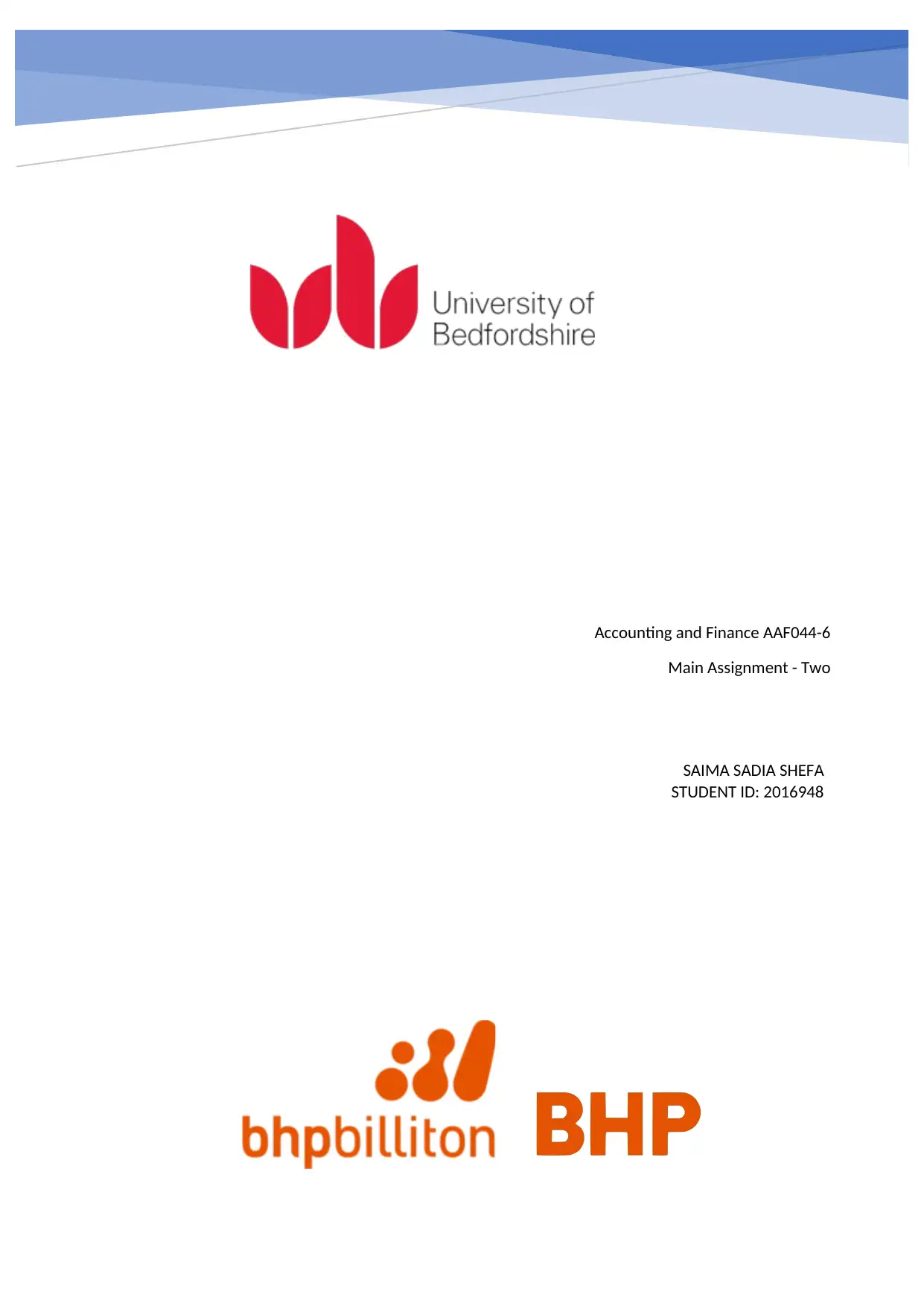
Accounting and Finance AAF044-6
Main Assignment - Two
SAIMA SADIA SHEFA
STUDENT ID: 2016948
Main Assignment - Two
SAIMA SADIA SHEFA
STUDENT ID: 2016948
Secure Best Marks with AI Grader
Need help grading? Try our AI Grader for instant feedback on your assignments.

Table of Contents
1.0 Introduction
2.0 Capital investment decisions techniques
2.1 Discounted cash flow techniques
2.1.1 PayBack Period
2.1.2 Accounting rate of return
2.2 Non-discounted cash flow techniques
2.2.1 Net Present Value
2..2.2 Internal rate of return
2.2.3 Profitability Index
2.2.4 Discounted Payback Period
3.0 Benefits of budgeting and planning in organizations
3.1 Advantages of Capital Budgeting
3.2 Limitations of Capital Budgeting
4.0 The Concept Of Corporate Governance
4.1 Role of Shareholders in Corporate Governance
4.2 Board of directors in Corporate Governance
4.2.1 Role of Board of directors .............................................................12
4.3 Comply & Explain ............................................................................13
5.0 Conclusion
6.0 References
1 | Accounting and Finance (AAF044-6) Main Assignment two
1.0 Introduction
2.0 Capital investment decisions techniques
2.1 Discounted cash flow techniques
2.1.1 PayBack Period
2.1.2 Accounting rate of return
2.2 Non-discounted cash flow techniques
2.2.1 Net Present Value
2..2.2 Internal rate of return
2.2.3 Profitability Index
2.2.4 Discounted Payback Period
3.0 Benefits of budgeting and planning in organizations
3.1 Advantages of Capital Budgeting
3.2 Limitations of Capital Budgeting
4.0 The Concept Of Corporate Governance
4.1 Role of Shareholders in Corporate Governance
4.2 Board of directors in Corporate Governance
4.2.1 Role of Board of directors .............................................................12
4.3 Comply & Explain ............................................................................13
5.0 Conclusion
6.0 References
1 | Accounting and Finance (AAF044-6) Main Assignment two

1. Introduction
BHP Group (formerly BHP Billiton) is the Australian public corporation
along with BHP Group Plc based in the UK, form the BHP Group. It is the
largest mining company in the world and Australia's most valuable
company for its market capitalization. BHP was incorporated in 1885,
while Billiton roots trace back to 1851. In 2001, Billiton merged with the
Broken Hill Proprietary Company (BHP) to form BHP Billiton.
Company core objectives are - creating sustainable value for its
shareholders, employees, contractors, suppliers, customers, business
partners and host communities.
The company produces Iron ore and nickel in Western Australia,
metallurgical (steel-making) and energy coal in Queensland and New
South Wales, and copper in South Australia. It also operates projects in
Canada, Chile, Peru, the United States, Colombia and Brazil to produces
copper, iron ore, coal and potash. Its petroleum business operates in Gulf
of Mexico, Australia and Trinidad & Tobago.
BHP is a multinational company with operations on six continents and
offices in more than 100 countries (Dick, 2007). Company’s Global
headquarters is in Melbourne, Australia and Corporate office based in
London, UK.
BHP Group is operating as a Dual Listed Company, with two parent
companies: BHP Group Limited, which is listed on the ASX and the New
York Stock Exchange (NYSE) under the symbol BHP, and BHP Group Plc,
which is listed on the London Stock Exchange and the Johannesburg Stock
Exchange under the symbol BHP and on the NYSE under the symbol BBL.
Company’s Financial Challenges
BHP operates globally and company's main mission is to create long-term
shareholder value for natural resources around the world. The company
has a track record of providing significant shareholder returns by heavily
investing in mining projects for a long time. Apart from serving the needs
of its customers and rising economies, the company is devoted to
protecting the communities in which it operates as well as the
environment (Thompson and Macklin 2009).
The company faces significant financial difficulties because of its recent
decision to postpone expansion plans for some of its key projects and had
to put billions of dollars on hold. The issue emerged after the company
joined its competitors in delaying expansion plans due to the global
financial crisis.
2 | Accounting and Finance (AAF044-6) Main Assignment two
BHP Group (formerly BHP Billiton) is the Australian public corporation
along with BHP Group Plc based in the UK, form the BHP Group. It is the
largest mining company in the world and Australia's most valuable
company for its market capitalization. BHP was incorporated in 1885,
while Billiton roots trace back to 1851. In 2001, Billiton merged with the
Broken Hill Proprietary Company (BHP) to form BHP Billiton.
Company core objectives are - creating sustainable value for its
shareholders, employees, contractors, suppliers, customers, business
partners and host communities.
The company produces Iron ore and nickel in Western Australia,
metallurgical (steel-making) and energy coal in Queensland and New
South Wales, and copper in South Australia. It also operates projects in
Canada, Chile, Peru, the United States, Colombia and Brazil to produces
copper, iron ore, coal and potash. Its petroleum business operates in Gulf
of Mexico, Australia and Trinidad & Tobago.
BHP is a multinational company with operations on six continents and
offices in more than 100 countries (Dick, 2007). Company’s Global
headquarters is in Melbourne, Australia and Corporate office based in
London, UK.
BHP Group is operating as a Dual Listed Company, with two parent
companies: BHP Group Limited, which is listed on the ASX and the New
York Stock Exchange (NYSE) under the symbol BHP, and BHP Group Plc,
which is listed on the London Stock Exchange and the Johannesburg Stock
Exchange under the symbol BHP and on the NYSE under the symbol BBL.
Company’s Financial Challenges
BHP operates globally and company's main mission is to create long-term
shareholder value for natural resources around the world. The company
has a track record of providing significant shareholder returns by heavily
investing in mining projects for a long time. Apart from serving the needs
of its customers and rising economies, the company is devoted to
protecting the communities in which it operates as well as the
environment (Thompson and Macklin 2009).
The company faces significant financial difficulties because of its recent
decision to postpone expansion plans for some of its key projects and had
to put billions of dollars on hold. The issue emerged after the company
joined its competitors in delaying expansion plans due to the global
financial crisis.
2 | Accounting and Finance (AAF044-6) Main Assignment two

Another strategy for overcoming these challenges is to reduce income-
expenditure and real wages. The company also chose to decrease prices
in order to manage commodity prices, which worsened the situation.
2.0 Capital investment decisions techniques
Companies across the world expand by launching new initiatives and
making investments in various industries and areas. The research and
subsequent appraisal of these initiatives mainly based on economic, cost,
and financial data. Investment appraisal techniques helps managers in
determining the financial sustainability of individual projects as well as
making decisions such as the purchase of land, machinery, buildings, or
equipment etc.
Feasibility of any project or decisions making process usually done by
using different techniques and each technique assesses the project from a
different perspective and delivers a different insight. These techniques
can be classified into two parts:
Non-discounted cash flow techniques.
Discounted cash flow techniques.
2.1 Non-Discounted cash flow techniques
This is the traditional method and it does not consider the time value of
money. To put it another way, all future dollars are presumed to have the
same value as today's money. Non-discounted cash flow strategies
include the following two techniques:
Payback period
Accounting rate of return
3 | Accounting and Finance (AAF044-6) Main Assignment two
expenditure and real wages. The company also chose to decrease prices
in order to manage commodity prices, which worsened the situation.
2.0 Capital investment decisions techniques
Companies across the world expand by launching new initiatives and
making investments in various industries and areas. The research and
subsequent appraisal of these initiatives mainly based on economic, cost,
and financial data. Investment appraisal techniques helps managers in
determining the financial sustainability of individual projects as well as
making decisions such as the purchase of land, machinery, buildings, or
equipment etc.
Feasibility of any project or decisions making process usually done by
using different techniques and each technique assesses the project from a
different perspective and delivers a different insight. These techniques
can be classified into two parts:
Non-discounted cash flow techniques.
Discounted cash flow techniques.
2.1 Non-Discounted cash flow techniques
This is the traditional method and it does not consider the time value of
money. To put it another way, all future dollars are presumed to have the
same value as today's money. Non-discounted cash flow strategies
include the following two techniques:
Payback period
Accounting rate of return
3 | Accounting and Finance (AAF044-6) Main Assignment two
Secure Best Marks with AI Grader
Need help grading? Try our AI Grader for instant feedback on your assignments.
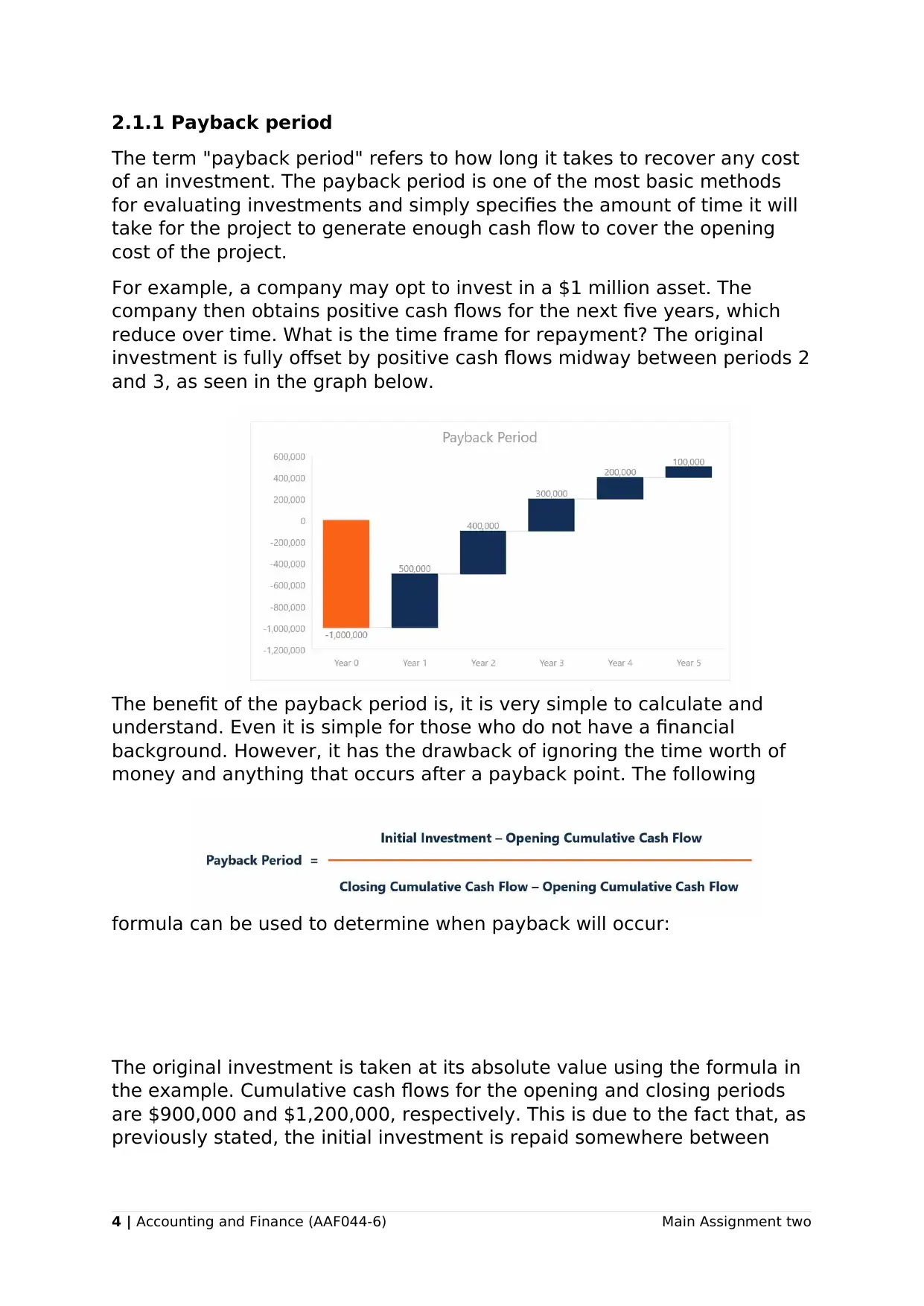
2.1.1 Payback period
The term "payback period" refers to how long it takes to recover any cost
of an investment. The payback period is one of the most basic methods
for evaluating investments and simply specifies the amount of time it will
take for the project to generate enough cash flow to cover the opening
cost of the project.
For example, a company may opt to invest in a $1 million asset. The
company then obtains positive cash flows for the next five years, which
reduce over time. What is the time frame for repayment? The original
investment is fully offset by positive cash flows midway between periods 2
and 3, as seen in the graph below.
The benefit of the payback period is, it is very simple to calculate and
understand. Even it is simple for those who do not have a financial
background. However, it has the drawback of ignoring the time worth of
money and anything that occurs after a payback point. The following
formula can be used to determine when payback will occur:
The original investment is taken at its absolute value using the formula in
the example. Cumulative cash flows for the opening and closing periods
are $900,000 and $1,200,000, respectively. This is due to the fact that, as
previously stated, the initial investment is repaid somewhere between
4 | Accounting and Finance (AAF044-6) Main Assignment two
The term "payback period" refers to how long it takes to recover any cost
of an investment. The payback period is one of the most basic methods
for evaluating investments and simply specifies the amount of time it will
take for the project to generate enough cash flow to cover the opening
cost of the project.
For example, a company may opt to invest in a $1 million asset. The
company then obtains positive cash flows for the next five years, which
reduce over time. What is the time frame for repayment? The original
investment is fully offset by positive cash flows midway between periods 2
and 3, as seen in the graph below.
The benefit of the payback period is, it is very simple to calculate and
understand. Even it is simple for those who do not have a financial
background. However, it has the drawback of ignoring the time worth of
money and anything that occurs after a payback point. The following
formula can be used to determine when payback will occur:
The original investment is taken at its absolute value using the formula in
the example. Cumulative cash flows for the opening and closing periods
are $900,000 and $1,200,000, respectively. This is due to the fact that, as
previously stated, the initial investment is repaid somewhere between
4 | Accounting and Finance (AAF044-6) Main Assignment two
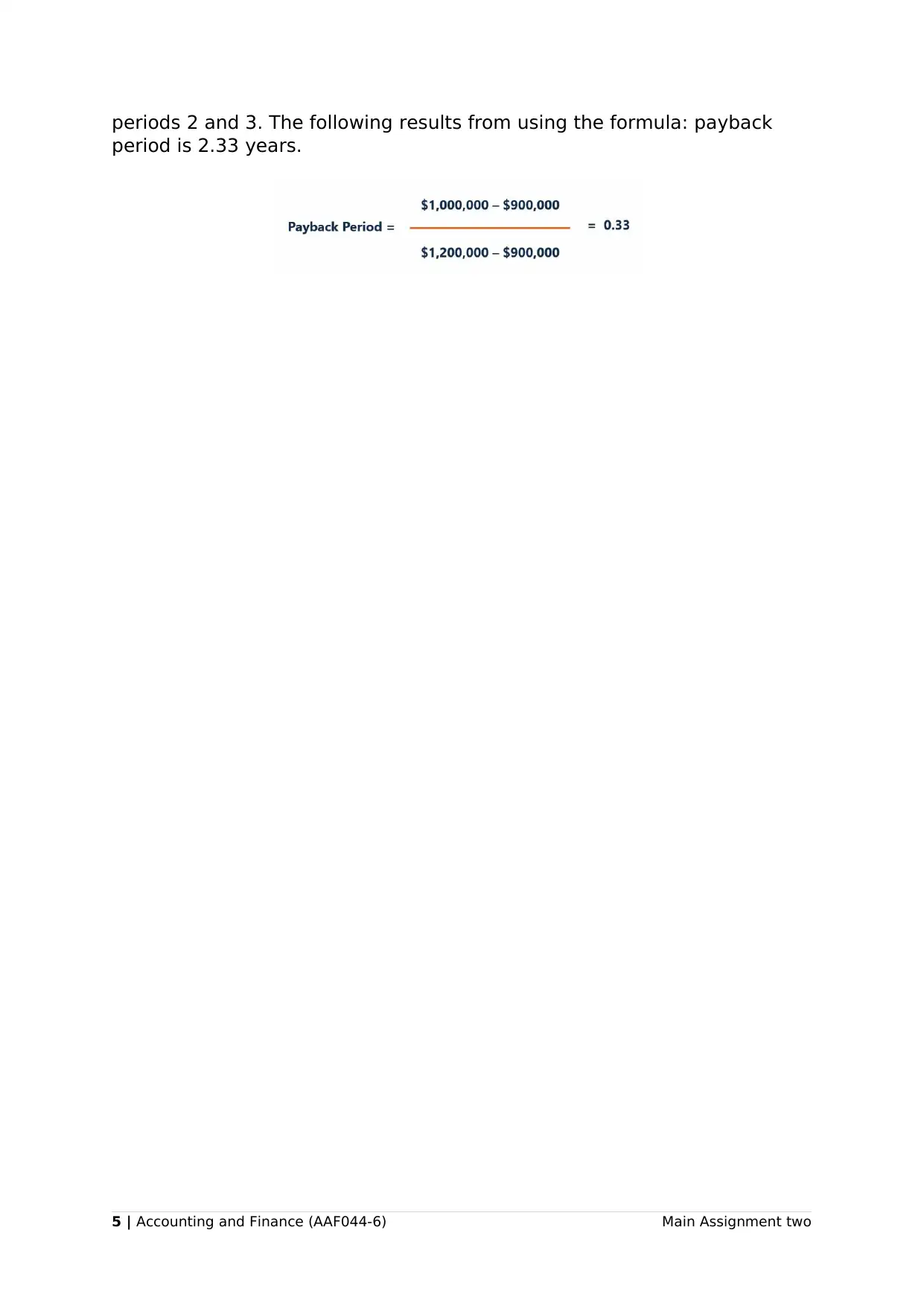
periods 2 and 3. The following results from using the formula: payback
period is 2.33 years.
5 | Accounting and Finance (AAF044-6) Main Assignment two
period is 2.33 years.
5 | Accounting and Finance (AAF044-6) Main Assignment two

2.1.2 Accounting rate of return
The accounting rate of return (ARR) is a capital budgeting ratio that
calculates the projected return on an investment in relation to the starting
cost. It represents the investment's net accounting profit as a proportion
of the capital investment. It's also referred to as return on capital or return
on investment. (Corporate Finance Institute, n.d.)
It is used when a company is selecting whether or not to invest in an asset
(a project, an acquisition, etc.) based on the predicted future net earnings
vs the capital cost.
The formula for ARR is:
ARR = Average Annual Profit / Average Investment
Where:
Average Annual Profit = Total profit over Investment Period /
Number of Years
Average Investment = (Book Value at Year 1 + Book Value at End
of Useful Life) / 2
For Example:
XYZ Inc. is looking to replace its present faulty machinery with new
equipment. The new machine, which costs $ 420,000, would bring in $
200,000 in yearly revenue and $ 50,000 in annual expenses. The
machine's useful life is anticipated to be 12 years.
Step 1: Calculate Average Annual Profit
Inflows, Years 1-12: (200,000*12) $2,400,000
Less: Annual Expenses: (50,000*12) -$600,000
Less: Depreciation -$420,000
Total Profit $1,380,000
Average Annual Profit (1,380,000/12) $115,000
Step 2: Calculate Average Investment
Average Investment ($420,000 + $0)/2 = $210,000
Step 3: Use ARR Formula
ARR = $115,000/$210,000 = 54.76%
Therefore, every dollar of investment will return a profit of around 54.76
cents.
2.2 Discounted cash flow techniques
6 | Accounting and Finance (AAF044-6) Main Assignment two
The accounting rate of return (ARR) is a capital budgeting ratio that
calculates the projected return on an investment in relation to the starting
cost. It represents the investment's net accounting profit as a proportion
of the capital investment. It's also referred to as return on capital or return
on investment. (Corporate Finance Institute, n.d.)
It is used when a company is selecting whether or not to invest in an asset
(a project, an acquisition, etc.) based on the predicted future net earnings
vs the capital cost.
The formula for ARR is:
ARR = Average Annual Profit / Average Investment
Where:
Average Annual Profit = Total profit over Investment Period /
Number of Years
Average Investment = (Book Value at Year 1 + Book Value at End
of Useful Life) / 2
For Example:
XYZ Inc. is looking to replace its present faulty machinery with new
equipment. The new machine, which costs $ 420,000, would bring in $
200,000 in yearly revenue and $ 50,000 in annual expenses. The
machine's useful life is anticipated to be 12 years.
Step 1: Calculate Average Annual Profit
Inflows, Years 1-12: (200,000*12) $2,400,000
Less: Annual Expenses: (50,000*12) -$600,000
Less: Depreciation -$420,000
Total Profit $1,380,000
Average Annual Profit (1,380,000/12) $115,000
Step 2: Calculate Average Investment
Average Investment ($420,000 + $0)/2 = $210,000
Step 3: Use ARR Formula
ARR = $115,000/$210,000 = 54.76%
Therefore, every dollar of investment will return a profit of around 54.76
cents.
2.2 Discounted cash flow techniques
6 | Accounting and Finance (AAF044-6) Main Assignment two
Paraphrase This Document
Need a fresh take? Get an instant paraphrase of this document with our AI Paraphraser

It is the method for reflecting the time value of money by discounting
future cash flows to the present. DCF analysis aims to determine the
current value of an investment based on forecasts of future earnings and
applies to decisions made by investors in firms or securities, such as
acquiring a company or purchasing a stock, as well as decisions made by
business owners and managers on capital budgeting and operating
expenses. (Corporate Finance Institute, n.d.) Discounted cash flow
techniques include the following:
Net present value
Internal rate of return
Profitability index
Discounted payback period
2.2.1 Net Present Value
The net present value rule is an investment idea that states that projects
should only be undertaken if their net present value (NPV) is positive. It is
the difference between the present value of cash inflows and cash
outflows over a given time period. NPV often used to evaluate projects in
capital planning as well as to examine and compare different investments.
(Investopedia, 2022)
Formula:
Simplified
way to remember
the concept of
NPV:
For example, A project will be started at a cost of $100,000 by XYZ
company. In year 1, year 2, and year 3, the project will generate cash flow
7 | Accounting and Finance (AAF044-6) Main Assignment two
future cash flows to the present. DCF analysis aims to determine the
current value of an investment based on forecasts of future earnings and
applies to decisions made by investors in firms or securities, such as
acquiring a company or purchasing a stock, as well as decisions made by
business owners and managers on capital budgeting and operating
expenses. (Corporate Finance Institute, n.d.) Discounted cash flow
techniques include the following:
Net present value
Internal rate of return
Profitability index
Discounted payback period
2.2.1 Net Present Value
The net present value rule is an investment idea that states that projects
should only be undertaken if their net present value (NPV) is positive. It is
the difference between the present value of cash inflows and cash
outflows over a given time period. NPV often used to evaluate projects in
capital planning as well as to examine and compare different investments.
(Investopedia, 2022)
Formula:
Simplified
way to remember
the concept of
NPV:
For example, A project will be started at a cost of $100,000 by XYZ
company. In year 1, year 2, and year 3, the project will generate cash flow
7 | Accounting and Finance (AAF044-6) Main Assignment two

of $ 40,000, $ 50,000, and $ 50,000, respectively. The Weighted Average
Cost of Capital (WACC) of the corporation is 10%. To find out NPV:
Formula of NPV = [ $40,000/ (1+0.1)1] + [ $ 50,000 / (1+0.1)2] + [ $
50,000/ (1+0.1)3] – 100,000
Net present value = $ 36,363.63 + $ 41,322.31 +$ 37,565.74 – $ 100,000
= $ 115,251.68 – $ 100,000
So, the net present value of the project is $ 15,251.68. Based on the NPV
rule, Since it is positive, the project should be undertaken.
2.2.2 Internal Rate of Return
The internal rate of return (IRR) is a financial analysis metric that is used
to calculate the profitability of possible investments. In a discounted cash
flow analysis, an IRR is a discount rate that makes the net present value
(NPV) of all cash flows equal to zero. (Investopedia, 2022)
In other words, IRR is the projected yearly growth rate of an investment.
IRR is calculated in the same way as net present value (NPV) is calculated,
with the exception that the NPV is set to zero.
Formula:
IRR's ultimate goal is to find the discount rate that makes the present
value of the sum of annual nominal cash inflows equal to the investment's
initial net cash outlay. When determining an expected return, several
approaches can be utilised, but IRR is frequently the best option for
examining the possible return of a new project that a company is
considering. (Investopedia, 2022)
8 | Accounting and Finance (AAF044-6) Main Assignment two
Cost of Capital (WACC) of the corporation is 10%. To find out NPV:
Formula of NPV = [ $40,000/ (1+0.1)1] + [ $ 50,000 / (1+0.1)2] + [ $
50,000/ (1+0.1)3] – 100,000
Net present value = $ 36,363.63 + $ 41,322.31 +$ 37,565.74 – $ 100,000
= $ 115,251.68 – $ 100,000
So, the net present value of the project is $ 15,251.68. Based on the NPV
rule, Since it is positive, the project should be undertaken.
2.2.2 Internal Rate of Return
The internal rate of return (IRR) is a financial analysis metric that is used
to calculate the profitability of possible investments. In a discounted cash
flow analysis, an IRR is a discount rate that makes the net present value
(NPV) of all cash flows equal to zero. (Investopedia, 2022)
In other words, IRR is the projected yearly growth rate of an investment.
IRR is calculated in the same way as net present value (NPV) is calculated,
with the exception that the NPV is set to zero.
Formula:
IRR's ultimate goal is to find the discount rate that makes the present
value of the sum of annual nominal cash inflows equal to the investment's
initial net cash outlay. When determining an expected return, several
approaches can be utilised, but IRR is frequently the best option for
examining the possible return of a new project that a company is
considering. (Investopedia, 2022)
8 | Accounting and Finance (AAF044-6) Main Assignment two

Two projects are being evaluated by a corporation. It has a ten percent
cost of capital. The following are the cash flow patterns for each:
Project A
Initial Outlay = $5,000
Year 1 = $1,700
Year 2 = $1,900
Year 3 = $1,600
Year 4 = $1,500
Year 5 = $700
Project B
Initial Outlay = $2,000
Year 1 = $400
Year 2 = $700
Year 3 = $500
Year 4r = $400
Year 5 = $300
Each project's IRR must be calculated by the company. There will be a
negative initial outlay (period = 0). The following equation can be used to
solve for IRR in an iterative process:
Project A’s IRR:
$0 = (−$5,000) + $1,700 ÷ (1 + IRR)1 + $1,900 ÷ (1 + IRR)2 + $1,600 ÷
(1 + IRR)3 + $1,500 ÷ (1 + IRR)4 + $700 ÷ (1 + IRR)5
IRR of Project A = 16.61 %
9 | Accounting and Finance (AAF044-6) Main Assignment two
cost of capital. The following are the cash flow patterns for each:
Project A
Initial Outlay = $5,000
Year 1 = $1,700
Year 2 = $1,900
Year 3 = $1,600
Year 4 = $1,500
Year 5 = $700
Project B
Initial Outlay = $2,000
Year 1 = $400
Year 2 = $700
Year 3 = $500
Year 4r = $400
Year 5 = $300
Each project's IRR must be calculated by the company. There will be a
negative initial outlay (period = 0). The following equation can be used to
solve for IRR in an iterative process:
Project A’s IRR:
$0 = (−$5,000) + $1,700 ÷ (1 + IRR)1 + $1,900 ÷ (1 + IRR)2 + $1,600 ÷
(1 + IRR)3 + $1,500 ÷ (1 + IRR)4 + $700 ÷ (1 + IRR)5
IRR of Project A = 16.61 %
9 | Accounting and Finance (AAF044-6) Main Assignment two
Secure Best Marks with AI Grader
Need help grading? Try our AI Grader for instant feedback on your assignments.
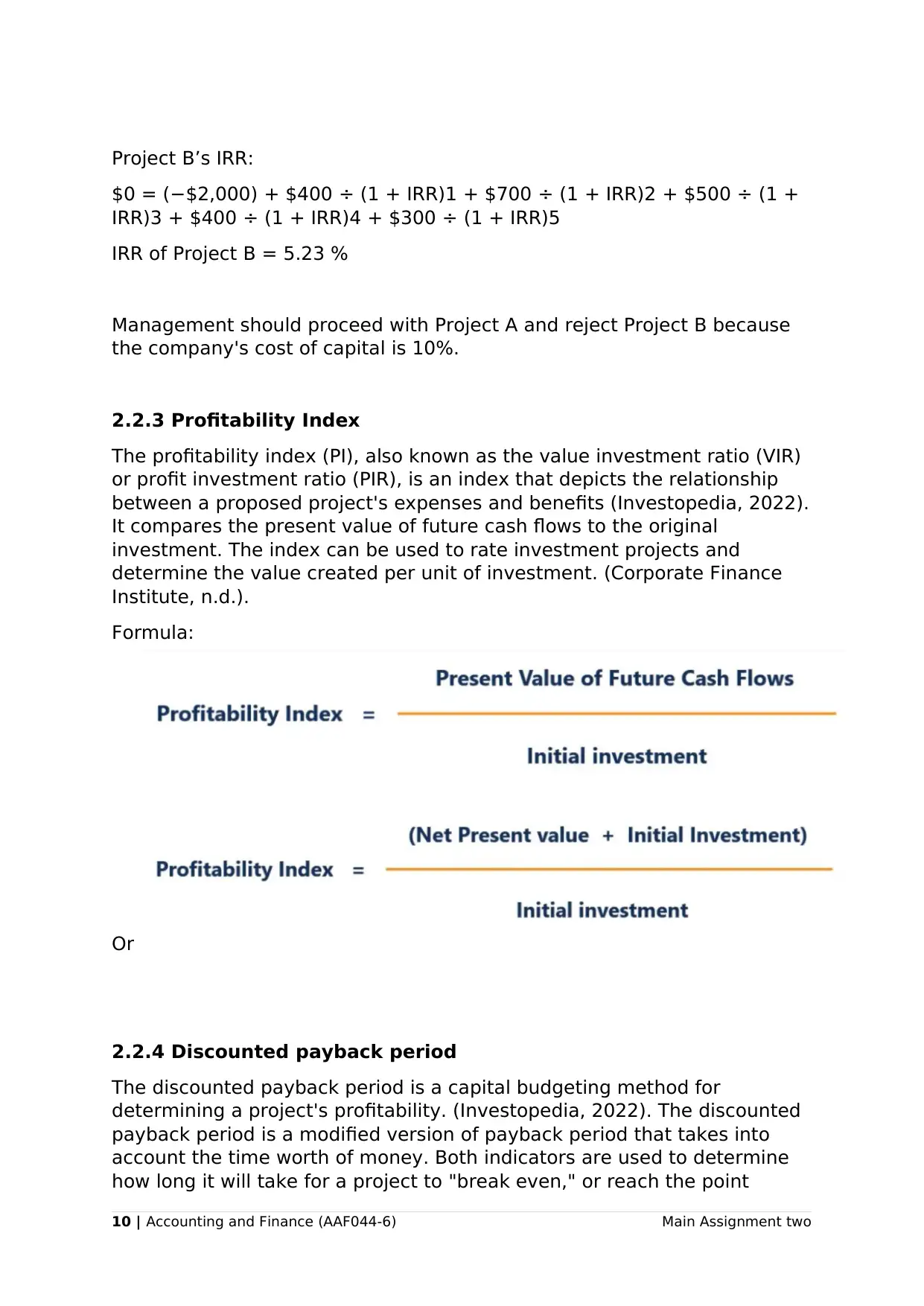
Project B’s IRR:
$0 = (−$2,000) + $400 ÷ (1 + IRR)1 + $700 ÷ (1 + IRR)2 + $500 ÷ (1 +
IRR)3 + $400 ÷ (1 + IRR)4 + $300 ÷ (1 + IRR)5
IRR of Project B = 5.23 %
Management should proceed with Project A and reject Project B because
the company's cost of capital is 10%.
2.2.3 Profitability Index
The profitability index (PI), also known as the value investment ratio (VIR)
or profit investment ratio (PIR), is an index that depicts the relationship
between a proposed project's expenses and benefits (Investopedia, 2022).
It compares the present value of future cash flows to the original
investment. The index can be used to rate investment projects and
determine the value created per unit of investment. (Corporate Finance
Institute, n.d.).
Formula:
Or
2.2.4 Discounted payback period
The discounted payback period is a capital budgeting method for
determining a project's profitability. (Investopedia, 2022). The discounted
payback period is a modified version of payback period that takes into
account the time worth of money. Both indicators are used to determine
how long it will take for a project to "break even," or reach the point
10 | Accounting and Finance (AAF044-6) Main Assignment two
$0 = (−$2,000) + $400 ÷ (1 + IRR)1 + $700 ÷ (1 + IRR)2 + $500 ÷ (1 +
IRR)3 + $400 ÷ (1 + IRR)4 + $300 ÷ (1 + IRR)5
IRR of Project B = 5.23 %
Management should proceed with Project A and reject Project B because
the company's cost of capital is 10%.
2.2.3 Profitability Index
The profitability index (PI), also known as the value investment ratio (VIR)
or profit investment ratio (PIR), is an index that depicts the relationship
between a proposed project's expenses and benefits (Investopedia, 2022).
It compares the present value of future cash flows to the original
investment. The index can be used to rate investment projects and
determine the value created per unit of investment. (Corporate Finance
Institute, n.d.).
Formula:
Or
2.2.4 Discounted payback period
The discounted payback period is a capital budgeting method for
determining a project's profitability. (Investopedia, 2022). The discounted
payback period is a modified version of payback period that takes into
account the time worth of money. Both indicators are used to determine
how long it will take for a project to "break even," or reach the point
10 | Accounting and Finance (AAF044-6) Main Assignment two

where the net cash flows generated exceed the project's starting cost.
(Corporate Finance Institute, n.d.)
3.0 Benefits of budgeting and planning in organizations
A budget is an estimate of future revenues and expenses that aids in the
planning of future expenses or resource allocation for a specific period. A
corporate budget is based on a set of assumptions and is in line with the
company's business strategy and goals. (Corporate Finance Institute, n.d.)
Capital budgeting (also called investment appraisal) is the most significant
tool in corporate finance for determining whether or not a company's
long-term investments are worthwhile. As stated in Corporate Finance by
Ehrhardt and Brigham, capital implies long-term assets that are utilized in
production and a budget is a plan that outlines anticipated expenditures
during a coming period (p 381). Forecasting and identifying cash flows,
performing scenario and sensitivity analysis, and using capital budgeting
tools are all part of the capital budgeting process. (Kwok & Rabe, 2010).
Capital budgeting is critical for manufacturing businesses of all sizes. Any
company that invests in a project without considering the risks and
rewards will lose money and have no chance of surviving in a competitive
market. Capital budgeting decisions helps in the making of two important
decisions: financial decisions and investment decisions.
3.1 Advantages of Capital Budgeting
It provides adequate project spending control.
It helps organisation to refrain from over investing and under-
investing.
Helps a company to understand the numerous risks associated with
an investment opportunity and how these risks affect the company's
returns.
A company can choose from a variety of capital budgeting
approaches and methods to determine whether or not a project is
financially viable.
All capital budgeting techniques/methods aim to generate
shareholder wealth and offer the organisation a competitive
advantage.
3.2 Limitations of Capital Budgeting
A poor capital budgeting decision might jeopardise the company's
long-term viability, thus it must be handled with care by
professionals who are familiar with the project.
11 | Accounting and Finance (AAF044-6) Main Assignment two
(Corporate Finance Institute, n.d.)
3.0 Benefits of budgeting and planning in organizations
A budget is an estimate of future revenues and expenses that aids in the
planning of future expenses or resource allocation for a specific period. A
corporate budget is based on a set of assumptions and is in line with the
company's business strategy and goals. (Corporate Finance Institute, n.d.)
Capital budgeting (also called investment appraisal) is the most significant
tool in corporate finance for determining whether or not a company's
long-term investments are worthwhile. As stated in Corporate Finance by
Ehrhardt and Brigham, capital implies long-term assets that are utilized in
production and a budget is a plan that outlines anticipated expenditures
during a coming period (p 381). Forecasting and identifying cash flows,
performing scenario and sensitivity analysis, and using capital budgeting
tools are all part of the capital budgeting process. (Kwok & Rabe, 2010).
Capital budgeting is critical for manufacturing businesses of all sizes. Any
company that invests in a project without considering the risks and
rewards will lose money and have no chance of surviving in a competitive
market. Capital budgeting decisions helps in the making of two important
decisions: financial decisions and investment decisions.
3.1 Advantages of Capital Budgeting
It provides adequate project spending control.
It helps organisation to refrain from over investing and under-
investing.
Helps a company to understand the numerous risks associated with
an investment opportunity and how these risks affect the company's
returns.
A company can choose from a variety of capital budgeting
approaches and methods to determine whether or not a project is
financially viable.
All capital budgeting techniques/methods aim to generate
shareholder wealth and offer the organisation a competitive
advantage.
3.2 Limitations of Capital Budgeting
A poor capital budgeting decision might jeopardise the company's
long-term viability, thus it must be handled with care by
professionals who are familiar with the project.
11 | Accounting and Finance (AAF044-6) Main Assignment two
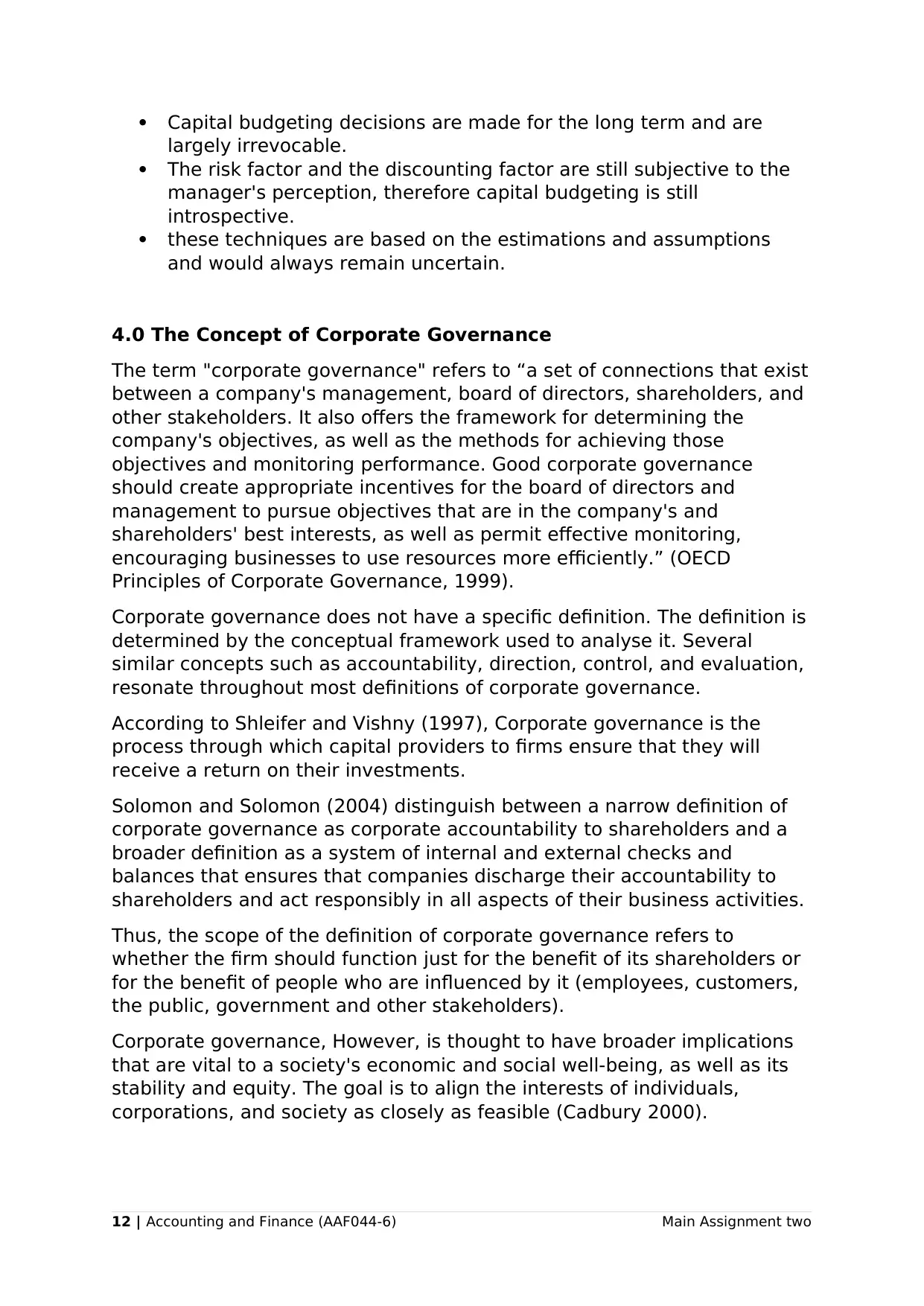
Capital budgeting decisions are made for the long term and are
largely irrevocable.
The risk factor and the discounting factor are still subjective to the
manager's perception, therefore capital budgeting is still
introspective.
these techniques are based on the estimations and assumptions
and would always remain uncertain.
4.0 The Concept of Corporate Governance
The term "corporate governance" refers to “a set of connections that exist
between a company's management, board of directors, shareholders, and
other stakeholders. It also offers the framework for determining the
company's objectives, as well as the methods for achieving those
objectives and monitoring performance. Good corporate governance
should create appropriate incentives for the board of directors and
management to pursue objectives that are in the company's and
shareholders' best interests, as well as permit effective monitoring,
encouraging businesses to use resources more efficiently.” (OECD
Principles of Corporate Governance, 1999).
Corporate governance does not have a specific definition. The definition is
determined by the conceptual framework used to analyse it. Several
similar concepts such as accountability, direction, control, and evaluation,
resonate throughout most definitions of corporate governance.
According to Shleifer and Vishny (1997), Corporate governance is the
process through which capital providers to firms ensure that they will
receive a return on their investments.
Solomon and Solomon (2004) distinguish between a narrow definition of
corporate governance as corporate accountability to shareholders and a
broader definition as a system of internal and external checks and
balances that ensures that companies discharge their accountability to
shareholders and act responsibly in all aspects of their business activities.
Thus, the scope of the definition of corporate governance refers to
whether the firm should function just for the benefit of its shareholders or
for the benefit of people who are influenced by it (employees, customers,
the public, government and other stakeholders).
Corporate governance, However, is thought to have broader implications
that are vital to a society's economic and social well-being, as well as its
stability and equity. The goal is to align the interests of individuals,
corporations, and society as closely as feasible (Cadbury 2000).
12 | Accounting and Finance (AAF044-6) Main Assignment two
largely irrevocable.
The risk factor and the discounting factor are still subjective to the
manager's perception, therefore capital budgeting is still
introspective.
these techniques are based on the estimations and assumptions
and would always remain uncertain.
4.0 The Concept of Corporate Governance
The term "corporate governance" refers to “a set of connections that exist
between a company's management, board of directors, shareholders, and
other stakeholders. It also offers the framework for determining the
company's objectives, as well as the methods for achieving those
objectives and monitoring performance. Good corporate governance
should create appropriate incentives for the board of directors and
management to pursue objectives that are in the company's and
shareholders' best interests, as well as permit effective monitoring,
encouraging businesses to use resources more efficiently.” (OECD
Principles of Corporate Governance, 1999).
Corporate governance does not have a specific definition. The definition is
determined by the conceptual framework used to analyse it. Several
similar concepts such as accountability, direction, control, and evaluation,
resonate throughout most definitions of corporate governance.
According to Shleifer and Vishny (1997), Corporate governance is the
process through which capital providers to firms ensure that they will
receive a return on their investments.
Solomon and Solomon (2004) distinguish between a narrow definition of
corporate governance as corporate accountability to shareholders and a
broader definition as a system of internal and external checks and
balances that ensures that companies discharge their accountability to
shareholders and act responsibly in all aspects of their business activities.
Thus, the scope of the definition of corporate governance refers to
whether the firm should function just for the benefit of its shareholders or
for the benefit of people who are influenced by it (employees, customers,
the public, government and other stakeholders).
Corporate governance, However, is thought to have broader implications
that are vital to a society's economic and social well-being, as well as its
stability and equity. The goal is to align the interests of individuals,
corporations, and society as closely as feasible (Cadbury 2000).
12 | Accounting and Finance (AAF044-6) Main Assignment two
Paraphrase This Document
Need a fresh take? Get an instant paraphrase of this document with our AI Paraphraser
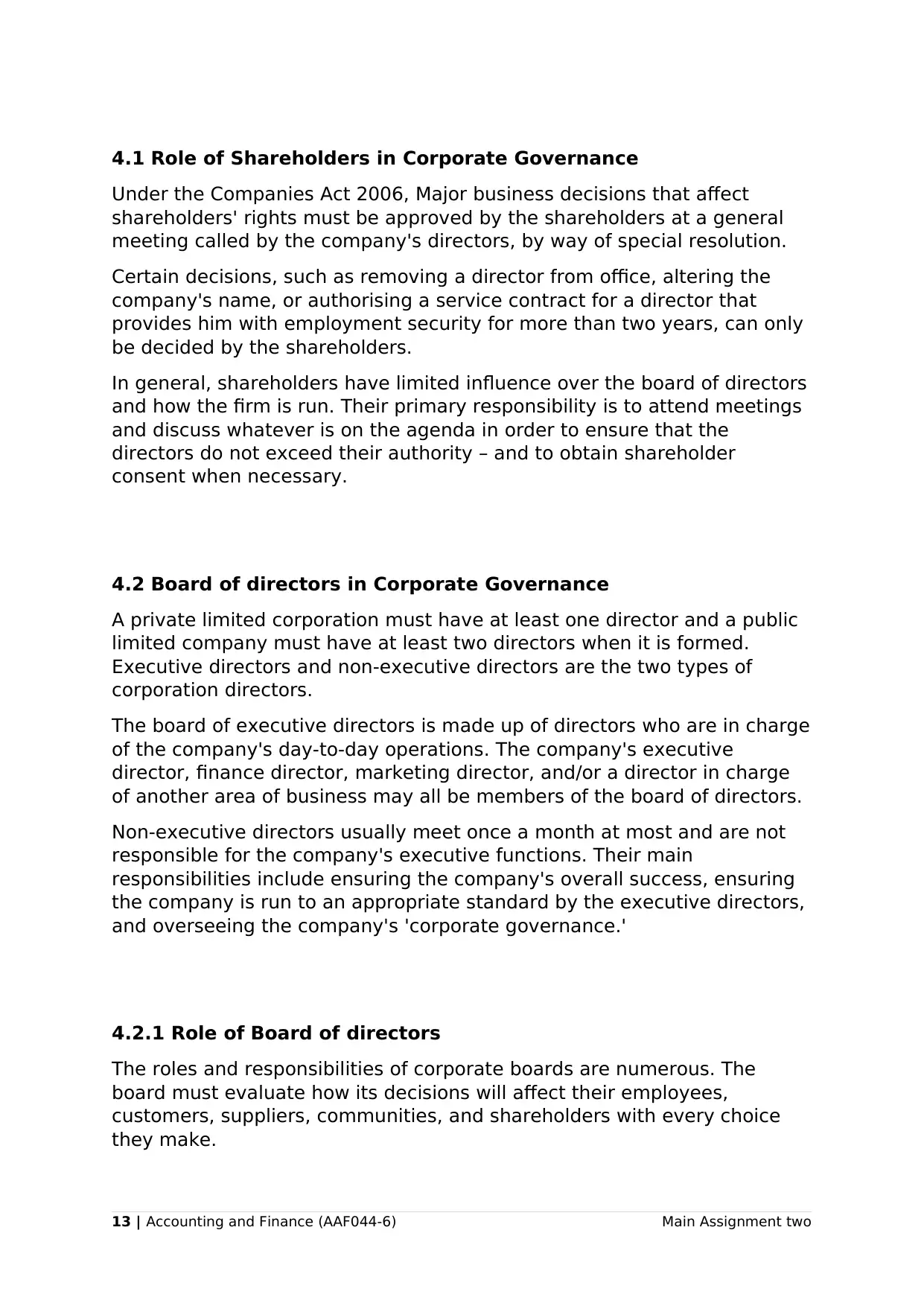
4.1 Role of Shareholders in Corporate Governance
Under the Companies Act 2006, Major business decisions that affect
shareholders' rights must be approved by the shareholders at a general
meeting called by the company's directors, by way of special resolution.
Certain decisions, such as removing a director from office, altering the
company's name, or authorising a service contract for a director that
provides him with employment security for more than two years, can only
be decided by the shareholders.
In general, shareholders have limited influence over the board of directors
and how the firm is run. Their primary responsibility is to attend meetings
and discuss whatever is on the agenda in order to ensure that the
directors do not exceed their authority – and to obtain shareholder
consent when necessary.
4.2 Board of directors in Corporate Governance
A private limited corporation must have at least one director and a public
limited company must have at least two directors when it is formed.
Executive directors and non-executive directors are the two types of
corporation directors.
The board of executive directors is made up of directors who are in charge
of the company's day-to-day operations. The company's executive
director, finance director, marketing director, and/or a director in charge
of another area of business may all be members of the board of directors.
Non-executive directors usually meet once a month at most and are not
responsible for the company's executive functions. Their main
responsibilities include ensuring the company's overall success, ensuring
the company is run to an appropriate standard by the executive directors,
and overseeing the company's 'corporate governance.'
4.2.1 Role of Board of directors
The roles and responsibilities of corporate boards are numerous. The
board must evaluate how its decisions will affect their employees,
customers, suppliers, communities, and shareholders with every choice
they make.
13 | Accounting and Finance (AAF044-6) Main Assignment two
Under the Companies Act 2006, Major business decisions that affect
shareholders' rights must be approved by the shareholders at a general
meeting called by the company's directors, by way of special resolution.
Certain decisions, such as removing a director from office, altering the
company's name, or authorising a service contract for a director that
provides him with employment security for more than two years, can only
be decided by the shareholders.
In general, shareholders have limited influence over the board of directors
and how the firm is run. Their primary responsibility is to attend meetings
and discuss whatever is on the agenda in order to ensure that the
directors do not exceed their authority – and to obtain shareholder
consent when necessary.
4.2 Board of directors in Corporate Governance
A private limited corporation must have at least one director and a public
limited company must have at least two directors when it is formed.
Executive directors and non-executive directors are the two types of
corporation directors.
The board of executive directors is made up of directors who are in charge
of the company's day-to-day operations. The company's executive
director, finance director, marketing director, and/or a director in charge
of another area of business may all be members of the board of directors.
Non-executive directors usually meet once a month at most and are not
responsible for the company's executive functions. Their main
responsibilities include ensuring the company's overall success, ensuring
the company is run to an appropriate standard by the executive directors,
and overseeing the company's 'corporate governance.'
4.2.1 Role of Board of directors
The roles and responsibilities of corporate boards are numerous. The
board must evaluate how its decisions will affect their employees,
customers, suppliers, communities, and shareholders with every choice
they make.
13 | Accounting and Finance (AAF044-6) Main Assignment two
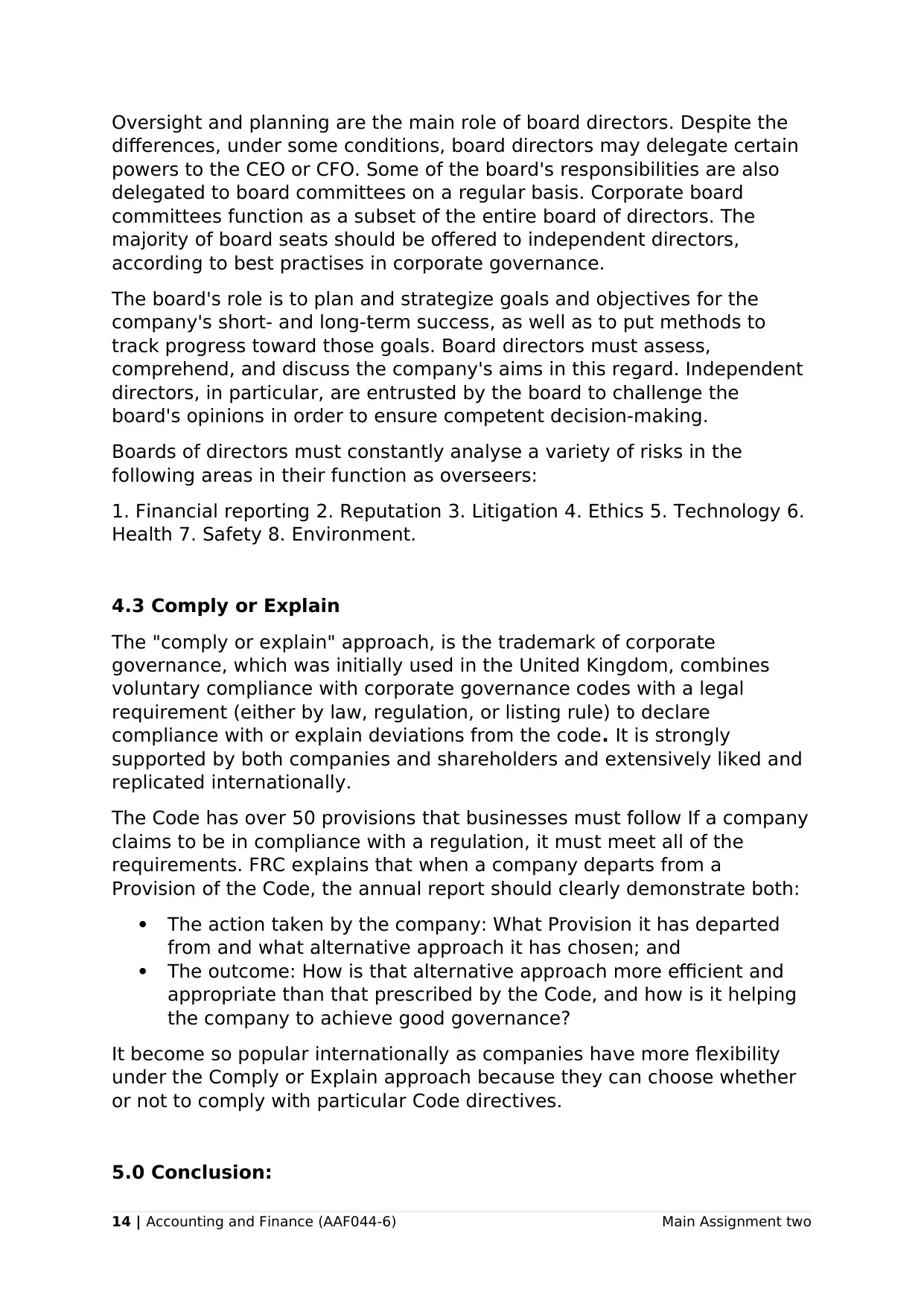
Oversight and planning are the main role of board directors. Despite the
differences, under some conditions, board directors may delegate certain
powers to the CEO or CFO. Some of the board's responsibilities are also
delegated to board committees on a regular basis. Corporate board
committees function as a subset of the entire board of directors. The
majority of board seats should be offered to independent directors,
according to best practises in corporate governance.
The board's role is to plan and strategize goals and objectives for the
company's short- and long-term success, as well as to put methods to
track progress toward those goals. Board directors must assess,
comprehend, and discuss the company's aims in this regard. Independent
directors, in particular, are entrusted by the board to challenge the
board's opinions in order to ensure competent decision-making.
Boards of directors must constantly analyse a variety of risks in the
following areas in their function as overseers:
1. Financial reporting 2. Reputation 3. Litigation 4. Ethics 5. Technology 6.
Health 7. Safety 8. Environment.
4.3 Comply or Explain
The "comply or explain" approach, is the trademark of corporate
governance, which was initially used in the United Kingdom, combines
voluntary compliance with corporate governance codes with a legal
requirement (either by law, regulation, or listing rule) to declare
compliance with or explain deviations from the code. It is strongly
supported by both companies and shareholders and extensively liked and
replicated internationally.
The Code has over 50 provisions that businesses must follow If a company
claims to be in compliance with a regulation, it must meet all of the
requirements. FRC explains that when a company departs from a
Provision of the Code, the annual report should clearly demonstrate both:
The action taken by the company: What Provision it has departed
from and what alternative approach it has chosen; and
The outcome: How is that alternative approach more efficient and
appropriate than that prescribed by the Code, and how is it helping
the company to achieve good governance?
It become so popular internationally as companies have more flexibility
under the Comply or Explain approach because they can choose whether
or not to comply with particular Code directives.
5.0 Conclusion:
14 | Accounting and Finance (AAF044-6) Main Assignment two
differences, under some conditions, board directors may delegate certain
powers to the CEO or CFO. Some of the board's responsibilities are also
delegated to board committees on a regular basis. Corporate board
committees function as a subset of the entire board of directors. The
majority of board seats should be offered to independent directors,
according to best practises in corporate governance.
The board's role is to plan and strategize goals and objectives for the
company's short- and long-term success, as well as to put methods to
track progress toward those goals. Board directors must assess,
comprehend, and discuss the company's aims in this regard. Independent
directors, in particular, are entrusted by the board to challenge the
board's opinions in order to ensure competent decision-making.
Boards of directors must constantly analyse a variety of risks in the
following areas in their function as overseers:
1. Financial reporting 2. Reputation 3. Litigation 4. Ethics 5. Technology 6.
Health 7. Safety 8. Environment.
4.3 Comply or Explain
The "comply or explain" approach, is the trademark of corporate
governance, which was initially used in the United Kingdom, combines
voluntary compliance with corporate governance codes with a legal
requirement (either by law, regulation, or listing rule) to declare
compliance with or explain deviations from the code. It is strongly
supported by both companies and shareholders and extensively liked and
replicated internationally.
The Code has over 50 provisions that businesses must follow If a company
claims to be in compliance with a regulation, it must meet all of the
requirements. FRC explains that when a company departs from a
Provision of the Code, the annual report should clearly demonstrate both:
The action taken by the company: What Provision it has departed
from and what alternative approach it has chosen; and
The outcome: How is that alternative approach more efficient and
appropriate than that prescribed by the Code, and how is it helping
the company to achieve good governance?
It become so popular internationally as companies have more flexibility
under the Comply or Explain approach because they can choose whether
or not to comply with particular Code directives.
5.0 Conclusion:
14 | Accounting and Finance (AAF044-6) Main Assignment two
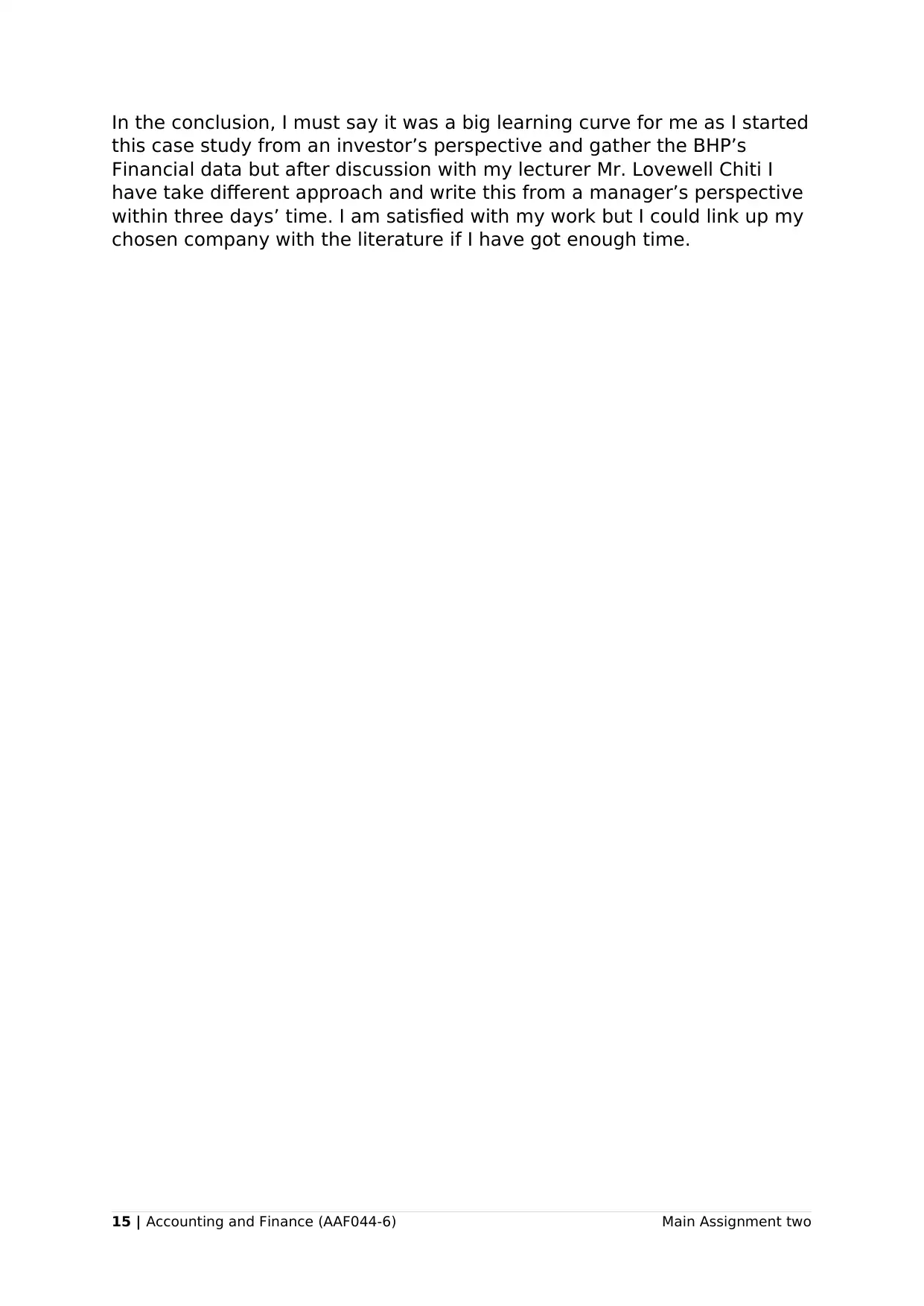
In the conclusion, I must say it was a big learning curve for me as I started
this case study from an investor’s perspective and gather the BHP’s
Financial data but after discussion with my lecturer Mr. Lovewell Chiti I
have take different approach and write this from a manager’s perspective
within three days’ time. I am satisfied with my work but I could link up my
chosen company with the literature if I have got enough time.
15 | Accounting and Finance (AAF044-6) Main Assignment two
this case study from an investor’s perspective and gather the BHP’s
Financial data but after discussion with my lecturer Mr. Lovewell Chiti I
have take different approach and write this from a manager’s perspective
within three days’ time. I am satisfied with my work but I could link up my
chosen company with the literature if I have got enough time.
15 | Accounting and Finance (AAF044-6) Main Assignment two
1 out of 16
Related Documents
Your All-in-One AI-Powered Toolkit for Academic Success.
+13062052269
info@desklib.com
Available 24*7 on WhatsApp / Email
![[object Object]](/_next/static/media/star-bottom.7253800d.svg)
Unlock your academic potential
© 2024 | Zucol Services PVT LTD | All rights reserved.
![[SOLVED] BHP Billiton Analysis and Recommendation](/_next/image/?url=https%3A%2F%2Fdesklib.com%2Fmedia%2Fimages%2Fch%2F1f73e73fa007458f851d516d107fc03f.jpg&w=256&q=75)



